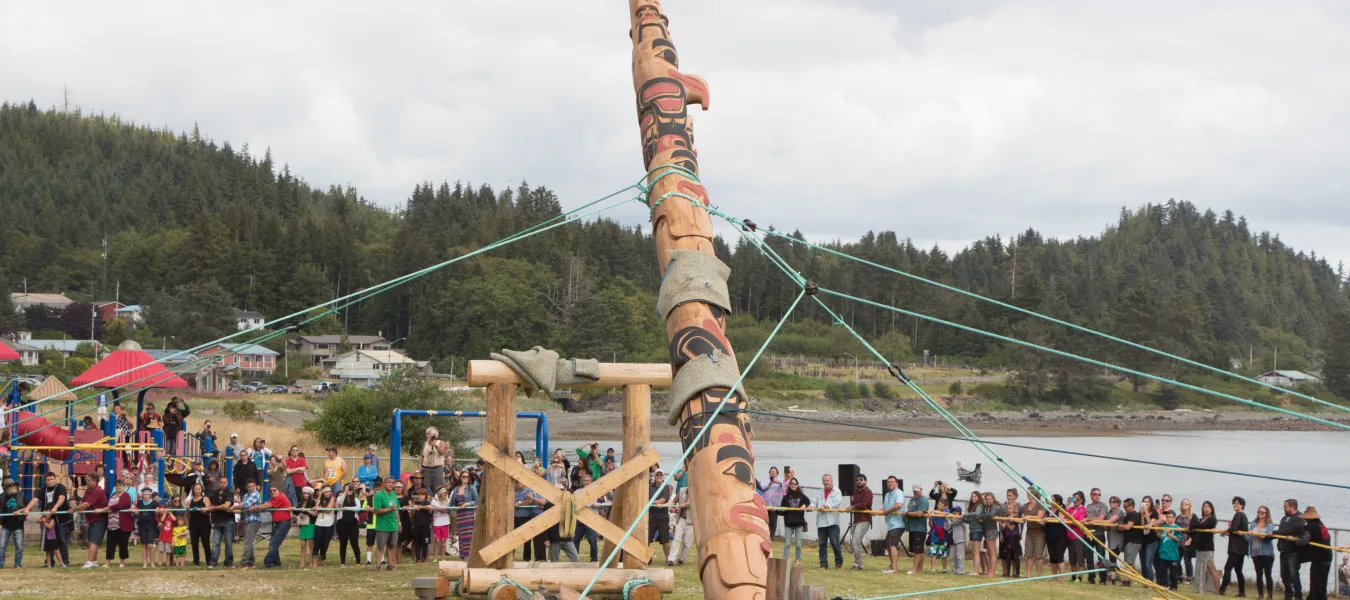Traditional Alaskan Artifacts
Southwest
This Alaskan drum is currently held in the University of Alaska Museum of the North located in Fairbanks, Alaska. Although, the date of creation is unknown the location of where its history began was in Western Alaska and the Aleutian Islands. The drum itself is an artist physical item, and added in the detailed art shows a man successfully seal hunting in a kayak. In my community, a woman has recently married to a traditional drum maker out of whale stomach and wood. We annually hold potlatches and dance with the drums. The totem pole pictured to the right was created by two men who were generously paid. They were to carve new totem poles to replace the older ones so that it can represent the first people's of the Alaskan community of Juneau. It is meaningful to me because I always thought it was interesting that Alaskan cultures were a part of the wood carving culture.
Interior
This moose antler arch was built in 2010 to represent the Alaskan Hunting History or the history of Alaskan hunting. The authors are all those who have generously donated their antlers from a moose that they had caught personally. The arch is located for view online and in-person in Fairbanks, Alaska 101 Dunkel Street. Every winter these antlers light up with Christmas lights and it the most beautiful thing to see. That is why I have chosen to include the antlers, also because I love hunting for moose.
This is artist David Anagaiak with his handmade mens' dance fan. It is shared that this is his most recent pair made in 2023. Since I was in grade school, we have created men's dance fans as an art project for our annual potlatch. This is why I have chosen to include the artist and the pieces because there are not a lot of traditional dance fan makers anymore.
This is a real time hand made boat and the builders are unknown. However, it is estimated to have been made in 1887. It is currently located at Hood Museum of Art, Dartmouth College: Gift of the Smithsonian Institution. Personally, this has a lot of meaning to me because I have always wanted to experience being in a handmade kayak. The stories that are told while these are used to hunt and fish for the communities are great.
My Alaskan Connection
As an Alaskan Native I have chose these pieces because I understand them or want to understand them. I chose the drum because in my community in St. Mary's, Alaska we have Yuraq dances every week when we can. I have chose the totem poles because my ancestors are from the Aleutian Islands: Unalaska, Alaska. The moose arch is personal for me because we attend University of Alaska Fairbanks, so I wanted to include the beautiful peace. In this article, I also have chosen mens' dance fans because they are simple to make. They are basic but they are beautiful and also have a lot of meaning. Lastly, I have chosen the handmade boats of Barrow, Alaska because I always wanted to take a trip there. They are beautiful and what they bring for a community is amazing.
Citation
Jamieson, Sandy. “Antler Arch Web Cam.” Morris Thompson Cultural Visitors Center, 11 Dec. 2024, morristhompsoncenter.org/antler-arch-web-cam/.
Holtzman, Bob. “Indigenous Boats.” Harvey Golden’s Magnificent Kayak Survey, Indigenous Boats, 19 Sept. 2016, indigenousboats.blogspot.com/2016/09/.
Niederreither, Marisa. “The Salmon Capital of the World!” The Salmon Capital of the World!, Marisa’s Alaskan Adventure, 10 Aug. 2023, marisasalaskanadventure.blogspot.com/2013/08/the-salmon-capital-of-world.html.
Thompson, Deb. “Fairbanks Antler Arch.” Atlas Obscura, Atlas Obscura, 3 Feb. 2014, www.atlasobscura.com/places/fairbanks-antler-arch.
https://www.naaer.hoodmuseum.dartmouth.edu/arctic-subarctic/tools-technology/work-3#:~:text=Like%20kayaks%2C%20umiaks%20traditionally%20consisted,be%20carried%20over%20the%20ice.
https://www.naaer.hoodmuseum.dartmouth.edu/arctic-subarctic/tools-technology/work-3#:~:text=Like%20kayaks%2C%20umiaks%20traditionally%20consisted,be%20carried%20over%20the%20ice.
https://www.atlasobscura.com/places/fairbanks-antler-arch
https://www.youtube.com/watch?v=a3iEn99UyR8
https://www.kyuk.org/arts-culture-community-features/2023-03-26/digging-into-his-yupik-roots-david-angaiak-sells-dance-fans-at-his-first-cama-i







Hello Dakota, I'm so excited that somebody did a blog on specifically southwestern Native Alaskan works. As somebody who has native ties to the Aleutian chain from my ancestors, I can't help but be in awe of the resourcefulness of native Alaskans. Specifically with the drum from the whale stomach being made, because they really did use every part of the animal and make use of every little thing, no matter how big or small it was. From your blog, I absolutely love the antler arch picture that you chose; it is a very well-centered picture of a monument to Alaska Native culture. Do wish that in your descriptions you went a little more in-depth with the photos. In relation to the theme, you very clearly have a strong bond with traditional Alaska Native artifacts. I would say that it's not just tied to a broad Alaskan identity but to specific cultural practices such as storytelling, dance, and craftsmanship. I personally feel that you have effectively shown in your blog that these traditional artifacts from these different cultures aren't just artifacts because they're “old,” but they're still being practiced today. This shows how these cultures have passed down their practices throughout their generations.
ReplyDeleteI really loved your blog, your connection to these remarkable pieces of art, and insights about the drum and its role in the dances in St. Mary's really highlight the heartbeat of the community. It's incredible to think about how these traditions keep your ancestors' spirits alive. I'm particularly in awe of the moose antler arch, even living in Fairbanks, I have never heard of it and will have to go check it out!
ReplyDeleteI like your post and its focus on art and culture right here in Alaska! I moved here in the past year so I've been learning about the deep native culture here. This post was really informative. It was also neat to see a piece featured that I've seen in-person. I've seen the moose antler arch outside the cultural center. Thank you for sharing!
ReplyDelete